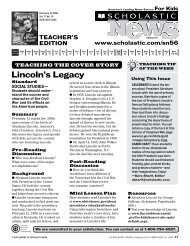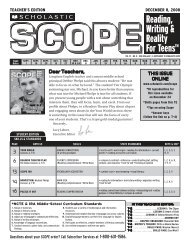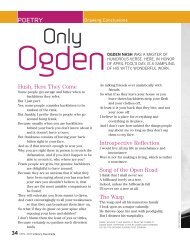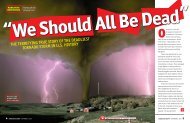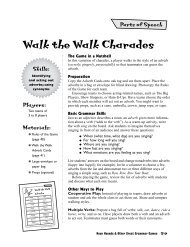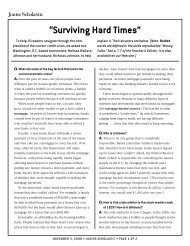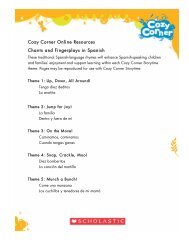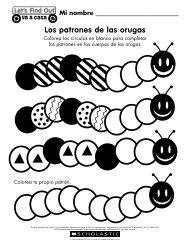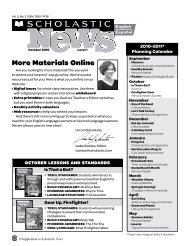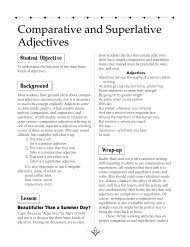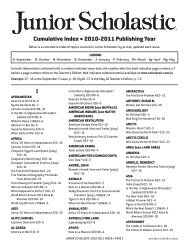Using the SRI to Improve Reading Performance - Scholastic
Using the SRI to Improve Reading Performance - Scholastic
Using the SRI to Improve Reading Performance - Scholastic
Create successful ePaper yourself
Turn your PDF publications into a flip-book with our unique Google optimized e-Paper software.
Because You Can’t Wait Until Spring:<br />
<strong>Using</strong> <strong>the</strong> <strong>SRI</strong> <strong>to</strong> <strong>Improve</strong><br />
<strong>Reading</strong> <strong>Performance</strong><br />
Kimberly A. Knutson,<br />
School District of Palm Beach County
<strong>Scholastic</strong> <strong>Reading</strong> Inven<strong>to</strong>ry (<strong>SRI</strong>) is an objective assessment of a student’s reading<br />
comprehension level. The computer adaptive assessment can be administered <strong>to</strong> students in<br />
Grades K—12 and is based on The Lexile Framework® for <strong>Reading</strong>. The test format supports<br />
quick administration in an un-timed, low-pressure environment. <strong>SRI</strong> is proven <strong>to</strong> be an effective<br />
assessment <strong>to</strong>:<br />
(1) Identify struggling readers.<br />
(2) Plan for instruction.<br />
(3) Gauge <strong>the</strong> effectiveness of a curriculum.<br />
(4) Demonstrate accountability.<br />
(5) Set growth goals.<br />
(6) Forecast state test outcomes.<br />
<strong>SRI</strong> focuses on <strong>the</strong> skills readers use when studying written materials sampled from various<br />
content areas. These skills include referring <strong>to</strong> details in <strong>the</strong> passage, drawing conclusions, and<br />
making comparisons and generalizations. <strong>SRI</strong> does not require prior knowledge of ideas outside<br />
of <strong>the</strong> passage, vocabulary taken out of context, or formal logic. <strong>SRI</strong> is built from au<strong>the</strong>ntic<br />
passages that are typical of <strong>the</strong> materials students read both in and out of school.<br />
• The “embedded completion” item format used with <strong>SRI</strong> has been shown <strong>to</strong> measure <strong>the</strong><br />
same core reading com p e t e n cy that is measured by norm - re fe re n c e d , c ri t e ri on - re fe re n c e d ,<br />
and individually administered reading tests.<br />
• The calibration equation used <strong>to</strong> calibrate <strong>SRI</strong> test items is <strong>the</strong> same equation that is<br />
used <strong>to</strong> measure books/texts. Thus, readers and texts are placed on <strong>the</strong> same scale. A<br />
multi-stage review process was used <strong>to</strong> ensure conformance with <strong>the</strong> text sampling and<br />
item writing specifications.<br />
• <strong>SRI</strong> uses a Bayesian scoring algorithm, which provides a paradigm for combining prior<br />
information with current data, <strong>to</strong> come up with an estimate of current reading level.<br />
This methodology connects each test administration <strong>to</strong> every o<strong>the</strong>r administration and<br />
thus produces a highly precise measurement.<br />
S RI is designed <strong>to</strong> measure a reading ability with texts of increasing difficulty. Once this measure<br />
is obtained, <strong>SRI</strong> can be used <strong>to</strong> set growth goals, moni<strong>to</strong>r progress, inform instruction, and<br />
predict state test outcomes. <strong>SRI</strong> helps <strong>to</strong> ensure that every student becomes a competent and<br />
motivated reader by individualizing <strong>the</strong>ir learning experience based on <strong>the</strong>ir specific abilities.
INTRODUCTION<br />
While teachers typically have a good understanding of what students are expected <strong>to</strong><br />
k n ow and be able <strong>to</strong> do in order <strong>to</strong> demon s t rate basic gra d e - l evel reading<br />
p ro f i c i e n cy and <strong>to</strong> pre p a re <strong>the</strong>ir students for high-stakes ach i evement tests in re a d i n g,<br />
t h ey may not alw ays have timely or accurate inform a t i on <strong>to</strong> help individual students develop <strong>the</strong>ir<br />
reading skills. Moreover, because teachers may differ in <strong>the</strong>ir approach <strong>to</strong> reading instruction—<br />
both basic reading instruction and remedial interventions—<strong>the</strong>y are often in need of a measure<br />
that provides precise, useful information about reading ability that is aligned with end-of-year<br />
m e a s u res and is more or less neutral with respect <strong>to</strong> <strong>the</strong>ir chosen appro a ch <strong>to</strong> reading instru c t i on .<br />
This paper examines <strong>the</strong> re l a t i onship between such a measure of student reading leve l — t h e<br />
S cholastic <strong>Reading</strong> Inve n t o ry (<strong>SRI</strong> ) , and <strong>the</strong> measure of Fl o rida reading standard s , <strong>the</strong> Fl o ri d a<br />
Comprehensive Assessment Test, Sunshine State Standards (FCAT-SSS) <strong>Reading</strong>. Specifically<br />
this paper describes a study conducted <strong>to</strong> determine if Lexile scores from <strong>the</strong> <strong>SRI</strong> could pre d i c t<br />
F CAT-SSS reading scores at varying levels of pro f i c i e n cy. The study was done in order <strong>to</strong> prov i d e<br />
g ro u n d e d , s t a t i s t i ca lly sound inform a t i on that will enable Fl o rida teachers <strong>to</strong> identify early in <strong>the</strong><br />
f a ll semester students in danger of failing <strong>to</strong> ach i eve pro f i c i e n cy on <strong>the</strong> FCAT-SSS <strong>Reading</strong>. As a<br />
result of <strong>the</strong> study, a model of fall - t o - s p ring growth was developed that can be used <strong>to</strong> inform<br />
i n s t ru c t i onal practice over <strong>the</strong> school ye a r. This model can be thought of as a <strong>to</strong>ol for ca l i b ra t i n g<br />
student reading level with <strong>the</strong> difficulty of cl a s s ro om materials in order <strong>to</strong> tailor effe c t i ve interve nt<br />
i ons based on specific growth “ t a r g e t s ” at <strong>the</strong> individual student leve l .<br />
Indeed, <strong>the</strong> results of <strong>the</strong> study point <strong>to</strong> a classroom assessment that is statistically “aligned” <strong>to</strong><br />
high-stakes state test results and that can be used <strong>to</strong> identify students in need of assistance,<br />
effectively guiding instructional interventions early in <strong>the</strong> school year. By providing teachers with<br />
an effective classroom assessment <strong>to</strong>ol that produces a metric that describes both <strong>the</strong> complexity<br />
of text and student reading comprehension, and that is known <strong>to</strong> be related <strong>to</strong> high stakes state<br />
test results, teachers can <strong>the</strong>n:<br />
1. Align instructional materials <strong>to</strong> state standards and scaffold student<br />
comprehension instruction.<br />
2. Establish realistic, informed student achievement growth goals based<br />
on students’ initial reading comprehension level.<br />
3. M oni<strong>to</strong>r an instru c t i onal plan <strong>to</strong> help students at all levels demon s t ra t e<br />
proficiency in meeting reading standards.<br />
In o<strong>the</strong>r words, teachers using <strong>the</strong> <strong>SRI</strong> will be able <strong>to</strong> obtain <strong>the</strong> data <strong>the</strong>y need throughout<br />
<strong>the</strong> year <strong>to</strong> moni<strong>to</strong>r student progress, set goals according <strong>to</strong> reading level, and adjust<br />
instruction appropriately.<br />
1
Participants<br />
M E T H O D<br />
In SY2001–2002, <strong>SRI</strong> and FCAT-SSS <strong>Reading</strong> data were collected from all students attending<br />
Grades 3–10 in schools in <strong>the</strong> School District of Palm Beach County (SDPBC). <strong>SRI</strong> data were<br />
collected from second-grade students in <strong>the</strong> spring of 2001. Table 1 shows <strong>the</strong> demographic<br />
characteristics by grade level of <strong>the</strong> students included in <strong>the</strong> study.<br />
Brief Description of <strong>the</strong> Measures: FCAT-SSS <strong>Reading</strong> and <strong>SRI</strong><br />
FCAT-SSS <strong>Reading</strong><br />
The FCAT-SSS <strong>Reading</strong> is a criterion-referenced assessment intended <strong>to</strong> measure selected<br />
benchmarks from <strong>the</strong> Sunshine State Standards (SSS). Test items for Grades 3–10 are multiple<br />
choice, while additional, short, and extended response items are included on <strong>the</strong> tests<br />
administered at Grades 4, 8, and 10. Two types of scale scores are reported on FCAT-SSS<br />
<strong>Reading</strong>: (1) scale scores for each grade level (100–500 points), and (2) developmental scale<br />
scores (DSS) that span all grade levels (0–3,000). Internal consistency reliability scores produced<br />
by Cronbach’s Alpha on <strong>the</strong> SY2001–02 reading test range from .87 <strong>to</strong> .91 (Assessment, 2004).<br />
Table 1<br />
Demographic Characteristics of Students Enrolled in <strong>the</strong> School District of Palm Beach County<br />
in <strong>the</strong> Fall by School Year and Grade Level<br />
School Grade<br />
Year Level<br />
Number of African Free/Reduced<br />
Students American Hispanic White Lunch ESOL ESE<br />
Number Percent Percent Percent Percent Percent Percent<br />
2000–01 2 7,515 21.5 16.9 53.8 40.4 13.4 3.3<br />
2001–02 3 8,222 2.18 17.6 50.8 43.3 11.0 4.3<br />
4 9,774 28.1 17.5 48.1 47.9 8.9 7.2<br />
5 10,236 27.4 17.9 49.9 46.1 6.9 10.3<br />
6 10,717 27.0 17.9 50.3 43.3 3.6 9.5<br />
7 10,465 27.0 17.4 51.0 39.5 3.8 10.16<br />
8 9,935 26.3 16.4 52.7 34.6 4.8 9.72<br />
9 11,774 29.4 16.6 50.1 22.9 6.6 9.5<br />
10 6,876 20.9 13.9 59.8 15.0 5.4 5.6<br />
2
Table 2<br />
Correlations Between SY2001–02 Fall and Spring <strong>SRI</strong> Scores by Grade Level<br />
Grade Number of Students Correlation 1<br />
3 10,363 .81<br />
4 10,355 .81<br />
5 10,400 .82<br />
6 10,157 .83<br />
7 9,668 .84<br />
8 9,197 .84<br />
9 10,229 .85<br />
10 6,058 .81<br />
Criterion-related validity of <strong>the</strong> SY2001–02 FCAT-SSS was established by correlating <strong>the</strong><br />
FCAT-SSS <strong>Reading</strong> scores with <strong>the</strong> FCAT-NRT (Stanford 9) scores. The correlations between<br />
<strong>the</strong>se two tests range from .80 <strong>to</strong> .84 (Assessment, 2004). Students in Grades 3–10, including<br />
LEP and exceptional education students (EES) <strong>to</strong>ok <strong>the</strong> test in March of 2002. LEP and EES<br />
students who had current Individual Educational Plans (IEP) received accommodations <strong>to</strong><br />
complete <strong>the</strong> FCAT. The FCAT-SSS <strong>Reading</strong> has five achievement levels in <strong>to</strong>tal: levels 1-2 are<br />
below proficient, level 3 is <strong>the</strong> minimum level for a student <strong>to</strong> be classified as having attained<br />
proficiency at his grade level.<br />
<strong>SRI</strong><br />
The <strong>SRI</strong> is a computer adaptive test that measures reading com p re h e n s i on . R e a d i n g<br />
c om p re h e n s i on is opera t i on a lly defined on <strong>the</strong> <strong>SRI</strong> as: “p a ra ph rasing inform a t i on in <strong>the</strong> passage,<br />
d rawing logical con cl u s i ons based on inform a t i on in <strong>the</strong> passage, making an infe re n c e, i d e n t i f yi n g<br />
a supporting detail, or making a generalization based on information in <strong>the</strong> passage” (<strong>Scholastic</strong><br />
<strong>Reading</strong>, 2001, 5). Test items are based on au<strong>the</strong>ntic passages taken from textbooks, literature,<br />
and periodicals and consist, for each passage, of multiple-choice items with a fill-in-<strong>the</strong>-blank<br />
format. Because <strong>the</strong> several alternatives for each item could correctly fit in <strong>the</strong> blank when <strong>the</strong><br />
item is considered separate from <strong>the</strong> passage, students must understand <strong>the</strong> material <strong>the</strong>y have<br />
read in order <strong>to</strong> respond correctly.<br />
___________________________<br />
1 Correlations are significant at p
Sample Test Item from <strong>SRI</strong><br />
“I leaned back for a moment and let my eyes wander down below. We<br />
were way out over <strong>the</strong> ocean. I looked at my watch—a little more than<br />
t h i r ty minutes from Orlando so far. The sea looked choppy, even with <strong>the</strong><br />
bright, sunny wea<strong>the</strong>r. An occasional cloud cast its shadow down on <strong>the</strong><br />
s<strong>to</strong>ny-looking water surface.The wavering outline of <strong>the</strong> plane appeared<br />
and disappeared.”<br />
I had a good _________.<br />
nap<br />
view<br />
idea<br />
lunch<br />
<strong>SRI</strong> results are reported on a Lexile® scale, which is a developmental scale interpretable across<br />
grade levels. The Lexile score that a student receives indicates <strong>the</strong> most difficult text a student<br />
can comprehend with 75% or greater accuracy. In addition <strong>to</strong> being a measure of reading level,<br />
<strong>the</strong> Lexile scale is also used <strong>to</strong> characterize text. When applied <strong>to</strong> text, <strong>the</strong> Lexile scale serves as<br />
an index of <strong>the</strong> level of complexity of written materials, where variations in complexity result<br />
from such things as <strong>the</strong> frequency of <strong>the</strong> words that occur in <strong>the</strong> text as well as <strong>the</strong> length of <strong>the</strong><br />
sentences (Lennon & Burdick, 2004). As a result of this “dual purpose of Lexiles,” <strong>the</strong> two<br />
related scores—Lexiles as a measure of reading level and Lexiles as an index of text difficulty—<br />
can be easily used <strong>to</strong> form a natural bridge between reader and text.<br />
Table 2 (see page 3) shows that <strong>SRI</strong> test-retest correlations for School District of Palm Beach<br />
City (SDPBC) test takers in Grades 3–10 ranged from .81 <strong>to</strong> .85 for SY2001–02. The <strong>SRI</strong> was<br />
first administered <strong>to</strong> <strong>the</strong>se students in fall 2001 and <strong>the</strong>n in spring 2002. The <strong>SRI</strong> was also given<br />
<strong>to</strong> second-grade students first in spring 2001 and <strong>to</strong> <strong>the</strong> same group of students (enrolled <strong>the</strong>n<br />
in third grade) in fall 2001. The correlation for this administration was .78 (n=9,343).<br />
Criterion-related validity of <strong>the</strong> SY2001–02 <strong>SRI</strong> scores was established by correlating both fall<br />
and spring <strong>SRI</strong> scores <strong>to</strong> <strong>the</strong> spring 2002 FCAT-SSS <strong>Reading</strong> scores. The fall-<strong>to</strong>-spring<br />
correlations for Grades 3–10 range between .71–.76 while <strong>the</strong> spring-<strong>to</strong>-spring correlations<br />
range from .75–.82. The correlations by grade level are presented in Table 3 (see page 5). The<br />
correlation between <strong>the</strong> second-grade 2001 spring administration of <strong>SRI</strong> and <strong>the</strong> spring 2002<br />
third-grade FCAT-SSS <strong>Reading</strong> was .72 (n=9,687).<br />
4
Table 3<br />
Correlation of SY2001–02 Fall and Spring <strong>SRI</strong> Scores with Spring 2002<br />
FCAT-SSS <strong>Reading</strong> Scale Scores by Grade 2<br />
Grade Fall <strong>SRI</strong> Lexile Spring <strong>SRI</strong> Lexile<br />
3<br />
4<br />
5<br />
6<br />
7<br />
8<br />
9<br />
10<br />
Test Administration Procedures<br />
Results from <strong>the</strong> <strong>SRI</strong> and <strong>the</strong> FCAT-SSS <strong>Reading</strong> were collected in SY2001–02 through <strong>the</strong><br />
SDPBC districtwide assessment program. The <strong>SRI</strong> was administered two times: Students in<br />
Grades 3–10 completed <strong>the</strong> fall administration of <strong>the</strong> <strong>SRI</strong> between September 4 and Oc<strong>to</strong>ber<br />
12, 2001. Students in Grades 2–10 completed <strong>the</strong> spring administration of <strong>the</strong> <strong>SRI</strong> May 1–24,<br />
2002. Students in Grades 3–10 completed <strong>the</strong> FCAT-SSS <strong>Reading</strong> March 5–12, 2002.<br />
School testing coordina<strong>to</strong>rs followed <strong>the</strong> Florida Department of Education test administration<br />
guidelines when administering <strong>the</strong> FCAT-SSS <strong>Reading</strong>. The <strong>SRI</strong> was administered at each<br />
school site during <strong>the</strong> above testing administration windows set by <strong>the</strong> SDPBC. Elementary<br />
students completed <strong>the</strong> <strong>SRI</strong> with <strong>the</strong>ir homeroom teacher while secondary students tested in<br />
<strong>the</strong>ir reading or language arts class. All students were tested in <strong>the</strong> school computer lab.<br />
Although <strong>the</strong> <strong>SRI</strong> was not timed, all students were scheduled <strong>to</strong> complete <strong>the</strong> test during a onehour<br />
class period.<br />
Prior <strong>to</strong> <strong>the</strong> fall <strong>SRI</strong> testing session , e a ch school populated <strong>the</strong> <strong>SRI</strong> database, l o cated on <strong>the</strong> sch o o l<br />
file server, with a data file supplied by <strong>the</strong> district. The data file contained <strong>the</strong> names, student<br />
identification numbers, student passwords, and FCAT-NRT <strong>Reading</strong> (Stanford 9) Lexile scores<br />
c o llected from <strong>the</strong> prior school ye a r, w h i ch were generated by and purchased from Harcourt Brace.<br />
___________________________<br />
2 Correlations are significant at p
A default Lexile, established by specialists in <strong>the</strong> Curriculum and Instruction Department, was<br />
used <strong>to</strong> target <strong>the</strong> <strong>SRI</strong> test for students who did not participate in <strong>SRI</strong> or FCAT-NRT testing<br />
<strong>the</strong> prior school year. Graph 4 shows <strong>the</strong> default target Lexile for each grade level. This score is<br />
used for initial placement of <strong>the</strong> test taker in<strong>to</strong> <strong>the</strong> actual administration of <strong>the</strong> <strong>SRI</strong>, enabling<br />
<strong>the</strong> program <strong>to</strong> select initial test passages that are of appropriate level of difficulty based on an<br />
estimate of <strong>the</strong> student’s reading level.<br />
At <strong>the</strong> close of each testing window, <strong>the</strong> <strong>SRI</strong> data was electron i ca lly shipped <strong>to</strong> <strong>the</strong> district and<br />
posted <strong>to</strong> student re c o rds s<strong>to</strong>red on <strong>the</strong> mainfra m e . Prior <strong>to</strong> <strong>the</strong> spring testing session , e a ch sch o o l<br />
e l e c t ron i ca lly updated <strong>the</strong> school <strong>SRI</strong> database with inform a t i on for students new <strong>to</strong> <strong>the</strong> sch o o l .<br />
Graph 4<br />
Default Target <strong>SRI</strong> Lexile Scores<br />
1 0 0 0<br />
9 0 0<br />
8 0 0<br />
7 0 0<br />
6 0 0<br />
5 0 0<br />
4 0 0<br />
3 0 0<br />
2 0 0<br />
1 0 0<br />
0<br />
100<br />
2<br />
300<br />
500<br />
600<br />
3 4 5 6 7 8 9 10<br />
Grade Levels 2–10<br />
Statistical Relationship between <strong>the</strong> <strong>SRI</strong> and <strong>the</strong> FCAT-SSS<br />
<strong>Reading</strong><br />
St a n d a rd statistical re g re s s i on techniques were used <strong>to</strong> examine <strong>the</strong> pre d i c t i ve re l a t i onship betw e e n<br />
<strong>the</strong> <strong>SRI</strong> and <strong>the</strong> FCAT-SSS. Results of this analysis were used <strong>to</strong> establish <strong>the</strong> <strong>SRI</strong> scores<br />
equivalent <strong>to</strong> <strong>the</strong> FCAT-SSS scale scores that define <strong>the</strong> cut-points that demarcate achievement<br />
levels (1 through 5) for Grades 3–10. Regression was chosen because, unlike o<strong>the</strong>r methods that<br />
were applied <strong>to</strong> <strong>the</strong> data, <strong>the</strong> regression equation was most successful at accurately predicting<br />
6<br />
700<br />
800<br />
850<br />
875<br />
900
F CAT-SSS scores from fall <strong>SRI</strong> scores for students in FCAT-SSS <strong>Reading</strong> ach i evement level 3.<br />
This is <strong>the</strong> FCAT achievement level that <strong>the</strong> state defines as proficient, and is taken as defining<br />
grade-level performance within <strong>the</strong> SDPBC. Graph 5 shows a comparison of <strong>the</strong> accuracy of<br />
predicting spring FCAT achievement levels from 1) fall <strong>SRI</strong> scores from <strong>the</strong> same academic year<br />
as <strong>the</strong> predicted results, and 2) previous years FCAT achievement level. Accuracy was<br />
established by com p a ring <strong>the</strong> ach i evement level “p re d i c t e d” f rom <strong>the</strong> fall <strong>SRI</strong> score <strong>to</strong> <strong>the</strong> actual<br />
a ch i eve m e n t level. The percent of fall <strong>SRI</strong> scores accurately predicted was compared <strong>to</strong> <strong>the</strong><br />
percent of FCAT scores that maintained <strong>the</strong> same FCAT achievement level as <strong>the</strong> year prior. As<br />
<strong>the</strong> table shows, <strong>the</strong> fall <strong>SRI</strong> scores were nearly as accurate predic<strong>to</strong>rs as were FCAT- S S S<br />
s c o res from <strong>the</strong> previous spring.<br />
To align secon d - g rade student reading perf o rmance <strong>to</strong> <strong>the</strong> FCAT reading ach i evement leve l s ,<br />
t h i rd - g rade reading scale scores on <strong>the</strong> FCAT-SSS in SY2001–02 were re g ressed on SY2000–01<br />
s p ring <strong>SRI</strong> Lexile scores from all secon d - g rade students. SY2001–02 reading scale scores on<br />
<strong>the</strong> FCAT-SSS for all students in Grades 3–10 were re g ressed on <strong>the</strong>ir fall and <strong>the</strong>ir spri n g<br />
S RI score s .<br />
Graph 5<br />
Accuracy of SY2001–02 Actual vs. Predicted FCAT-SSS <strong>Reading</strong> Achievement Level (Spring 2002)<br />
Compared <strong>to</strong> Percent of Students who Scored <strong>the</strong> Same Achievement Level in Spring 2002 as in<br />
<strong>the</strong> Previous Year (Spring 2001) on FCAT-SSS <strong>Reading</strong><br />
70<br />
60<br />
50<br />
40<br />
30<br />
20<br />
10<br />
0<br />
53<br />
48<br />
55<br />
48 52<br />
48<br />
53<br />
3 4 5 6 7 8 9 10<br />
Grade Levels 3–10<br />
7<br />
49<br />
58<br />
49 55 52 51<br />
% Accurately Classified by Regression Based on SY2001–02 Fall <strong>SRI</strong> Lexile (Fall 2001)<br />
% Achieving Same SY2000–01 FCAT <strong>Reading</strong> Achievement Level (Spring 2001)<br />
46<br />
53
A Brief Digression on Regre s s i o n<br />
T h e re are two important re a s ons for establishing <strong>the</strong> pre d i c t i ve re l a t i onship between <strong>the</strong> <strong>SRI</strong> and<br />
<strong>the</strong> FCAT- S S S . By doing so, we can establish <strong>the</strong> value of <strong>the</strong> <strong>SRI</strong> as a <strong>to</strong>ol <strong>to</strong>: 1) identify early in<br />
<strong>the</strong> fall of <strong>the</strong> academic year those students re q u i ring help <strong>to</strong> develop <strong>the</strong>ir reading skill s , and 2)<br />
measure progress in reading throughout <strong>the</strong> year. The easiest way <strong>to</strong> establish this predictive<br />
relationship is <strong>to</strong> use a simple yet powerful statistical technique known as linear regression. In<br />
simplest term s , this technique reveals <strong>the</strong> linear, m a t h e m a t i cal re l a t i on s h i p, b e tween <strong>the</strong> values of<br />
two vari a b l e s . In our ca s e, re g re s s i on can be used <strong>to</strong> predict FCAT-SSS <strong>Reading</strong> scores for any<br />
student using <strong>the</strong>ir <strong>SRI</strong> score s .<br />
While we won’t go in<strong>to</strong> <strong>the</strong> actual details of this statistical technique, it is important <strong>to</strong> know <strong>the</strong><br />
two key values that regression analyses typically yield. These two values are <strong>the</strong> correlation<br />
between <strong>the</strong> two variables and <strong>the</strong> slope of <strong>the</strong> relationship between <strong>the</strong>se two variables. The<br />
correlation tells us how strong <strong>the</strong> relationship is and whe<strong>the</strong>r it is positive or negative. A strong<br />
directional correlation (in this case, positive) between <strong>the</strong> fall <strong>SRI</strong> scores and <strong>the</strong> FCAT-SSS<br />
<strong>Reading</strong> scores supports our confidence <strong>to</strong> predict (with some degree of accuracy) a certain score<br />
on <strong>the</strong> FCAT. The slope gives information about how much change on one variable (here <strong>the</strong><br />
predic<strong>to</strong>r, or <strong>SRI</strong>) is necessary <strong>to</strong> yield a unit change on <strong>the</strong> o<strong>the</strong>r (here, <strong>the</strong> FCAT-SSS<br />
R e a d i n g ) . One can see how both of <strong>the</strong>se pieces of inform a t i on are import a n t . In <strong>the</strong> next section,<br />
we will detail both <strong>the</strong> correlational strength and <strong>the</strong> slope of <strong>the</strong> relationship between <strong>SRI</strong><br />
scores and FCAT-SSS <strong>Reading</strong> scores for students in Grades 3 through 8. We will show how<br />
<strong>the</strong>se two pieces of information both can be used <strong>to</strong> aid identification, instructional planning,<br />
and progress moni<strong>to</strong>ring throughout <strong>the</strong> school year.<br />
Regression Results<br />
Table 2 (see page 3) shows <strong>the</strong> correlation between <strong>the</strong> SY2001–02 fall and spring <strong>SRI</strong> scores.<br />
Pre d i c t a b ly, this re l a t i onship is positive and strong and acts as a measure of <strong>the</strong> re l i a b i l i ty of <strong>the</strong> <strong>SRI</strong> .<br />
The corre l a t i ons between fall and spring <strong>SRI</strong> scores and <strong>the</strong> spring FCAT-SSS <strong>Reading</strong> score s<br />
a re presented in Table 3 (see page 5). As expected, <strong>the</strong> corre l a t i on is slightly higher betw e e n<br />
<strong>the</strong> spring <strong>SRI</strong> scores and <strong>the</strong> FCAT-SSS scores than that between <strong>the</strong> fall <strong>SRI</strong> scores and <strong>the</strong><br />
F CAT-SSS re s u l t s . The ave rage of <strong>the</strong> corre l a t i ons between <strong>the</strong> scores is .79 in <strong>the</strong> spri n g,<br />
while it is slightly lower in <strong>the</strong> fall , at .74. Also as expected, <strong>the</strong>se corre l a t i ons are lower than<br />
<strong>the</strong> corre l a t i on between <strong>the</strong> fall and spring <strong>SRI</strong> score s , <strong>the</strong> ave rage of which is .83. It is<br />
ev i d e n t , h ow eve r, at least for <strong>the</strong>se samples and gra d e s , that <strong>the</strong> ave rage corre l a t i ons betw e e n<br />
<strong>the</strong> spring <strong>SRI</strong> and <strong>the</strong> FCAT- S S S , and <strong>the</strong> fall and spring <strong>SRI</strong> score s , a re nearly equivalent.<br />
8
Each of <strong>the</strong>se pieces of evidence taken <strong>to</strong>ge<strong>the</strong>r provides strong evidence that <strong>the</strong> <strong>SRI</strong> can be<br />
effectively used <strong>to</strong> identify students in <strong>the</strong> fall for intervention. This follows from <strong>the</strong> simple<br />
fact, now established, that low or high scores on <strong>the</strong> <strong>SRI</strong> in <strong>the</strong> fall are related with low or<br />
high scores on <strong>the</strong> high stakes FCAT-SSS.<br />
The next question <strong>to</strong> ask is: What is <strong>the</strong> incremental increase on <strong>the</strong> FCAT-SSS <strong>Reading</strong> that on e<br />
gains for each unit increase on <strong>the</strong> <strong>SRI</strong>? The re a s on for asking this question is that <strong>the</strong> answer will<br />
indicate, when compared <strong>to</strong> standard fall <strong>to</strong> spring growth on <strong>the</strong> <strong>SRI</strong>, <strong>the</strong> amount that students<br />
will have <strong>to</strong> actually improve (as measured by <strong>the</strong> <strong>SRI</strong>) in order <strong>to</strong> achieve successful (i.e., level 3<br />
proficiency) scores on <strong>the</strong> FCAT-SSS. The answer is provided in Table 6, which includes results<br />
from <strong>the</strong> regression analysis described above. Two specific pieces of information are included: 1)<br />
<strong>the</strong> rate of change (or slope) between <strong>the</strong> predic<strong>to</strong>r variable and 2) <strong>the</strong> predicted vari a b l e, and <strong>the</strong><br />
i n t e rc e p t , w h i ch is <strong>the</strong> value of <strong>the</strong> predicted variable when <strong>the</strong> value of <strong>the</strong> predic<strong>to</strong>r is ze ro.<br />
The concept of <strong>the</strong> slope can be more easily unders<strong>to</strong>od if one remembers that <strong>the</strong> simple algebra i c<br />
formula for a line can be expressed as y = mx + b, where m is <strong>the</strong> slope, x is <strong>the</strong> independent<br />
v a ri a b l e, b is <strong>the</strong> value of y when x is equal <strong>to</strong> ze ro, and y is <strong>the</strong> dependent vari a b l e . In our ca s e, y i s<br />
<strong>the</strong> predicted variable and x is <strong>the</strong> predic<strong>to</strong>r. The slope yields an index of <strong>the</strong> expected change in<br />
<strong>the</strong> predicted variable for each unit change in <strong>the</strong> predic<strong>to</strong>r vari a b l e . For example, for Grade 3 <strong>the</strong><br />
increase is about .15 units on <strong>the</strong> FCAT developmental scale for each unit increase on <strong>the</strong> <strong>SRI</strong>.<br />
Table 6<br />
Regression Coefficients for Grades 3–8 for FCAT-SSS <strong>Reading</strong> and <strong>SRI</strong><br />
Y<br />
Predicted Variable<br />
FCAT <strong>Reading</strong><br />
FCAT <strong>Reading</strong><br />
FCAT <strong>Reading</strong><br />
FCAT <strong>Reading</strong><br />
FCAT <strong>Reading</strong><br />
FCAT <strong>Reading</strong><br />
FCAT <strong>Reading</strong><br />
FCAT <strong>Reading</strong><br />
X<br />
Predic<strong>to</strong>r Variable<br />
<strong>SRI</strong> Lexile<br />
<strong>SRI</strong> Lexile<br />
<strong>SRI</strong> Lexile<br />
<strong>SRI</strong> Lexile<br />
<strong>SRI</strong> Lexile<br />
<strong>SRI</strong> Lexile<br />
<strong>SRI</strong> Lexile<br />
<strong>SRI</strong> Lexile<br />
Grade Intercept<br />
Slope<br />
N<br />
3<br />
4<br />
5<br />
6<br />
7<br />
8<br />
9<br />
10<br />
239.60257<br />
219.60261<br />
175.18560<br />
170.05979<br />
167.23780<br />
161.30156<br />
148.43805<br />
178.60881<br />
9<br />
0.15750<br />
0.15265<br />
0.15923<br />
0.16010<br />
0.15162<br />
0.14380<br />
0.14022<br />
0.11825<br />
8,041<br />
9,564<br />
9,974<br />
10,584<br />
10,215<br />
9,718<br />
10,639<br />
6,312
Expected Growth<br />
As noted above, fall or spring <strong>SRI</strong> scores can be used <strong>to</strong> predict FCAT-SSS <strong>Reading</strong> scores.<br />
These predicted FCAT scores can be used <strong>to</strong> first identify <strong>the</strong> values that correspond <strong>to</strong> <strong>the</strong><br />
FCAT-SSS <strong>Reading</strong> cut scores that define <strong>the</strong> several achievement levels and <strong>the</strong>n, in a manner<br />
working backwards, “look up” <strong>the</strong> fall and spring <strong>SRI</strong> scores that are equivalent <strong>to</strong> those<br />
achievement level cut-points. <strong>Using</strong> <strong>the</strong>se <strong>SRI</strong> scores, we can develop a model of expected, or<br />
necessary growth.<br />
In o<strong>the</strong>r words, if we assume that <strong>the</strong> fall <strong>SRI</strong> score that corresponds <strong>to</strong> <strong>the</strong> FCAT-SSS <strong>Reading</strong><br />
level 3 cut score is <strong>the</strong> starting point, and <strong>the</strong> correlative spring <strong>SRI</strong> score defines <strong>the</strong> end point,<br />
that is <strong>the</strong> point where a student must be <strong>to</strong> maximize <strong>the</strong> likelihood that <strong>the</strong>y will be in (or<br />
remain in) achievement level 3 at <strong>the</strong> time of spring FCAT testing, <strong>the</strong>n we can use <strong>the</strong>se two<br />
points <strong>to</strong> define a trajec<strong>to</strong>ry for fall <strong>to</strong> spring growth, as explained below.<br />
Table 7 shows <strong>the</strong> <strong>SRI</strong> values for fall and spring that correspond <strong>to</strong> <strong>the</strong> several FCAT-SSS<br />
<strong>Reading</strong> achievement level cut-points. These correspondences were derived in several steps: first,<br />
for each grade, <strong>the</strong> grade-level FCAT scores (ranging from 100–500) were regressed on fall and<br />
spring <strong>SRI</strong> scores. This produced <strong>the</strong> regression coefficients shown in Table 6 (see page 9).<br />
<strong>Using</strong> <strong>the</strong>se equations, <strong>SRI</strong> scores could be used <strong>to</strong> predict FCAT scores on <strong>the</strong> grade-level scale.<br />
Based on <strong>the</strong>se predicted scores, <strong>the</strong> <strong>SRI</strong> scores that corresponded <strong>to</strong> <strong>the</strong> several cut-points on<br />
each grade-level scale were identified and, using conversion equations supplied by <strong>the</strong> Florida<br />
Department of Education, converted <strong>to</strong> <strong>the</strong> full developmental scale. These are <strong>the</strong> values in <strong>the</strong><br />
column labeled “Florida <strong>Reading</strong> DSS.” Converting <strong>the</strong> more limited, grade-level scales <strong>to</strong> <strong>the</strong><br />
full developmental scale enables more appropriate comparisons across grades and years of<br />
administration of <strong>the</strong> FCAT-SSS <strong>Reading</strong>.<br />
The central virtue of <strong>the</strong> information in Table 7 is that we can identify, using fall <strong>SRI</strong> scores for<br />
students at any “predicted” FCAT achievement level, how much growth a student will need <strong>to</strong><br />
show on <strong>the</strong> <strong>SRI</strong> from fall <strong>to</strong> spring <strong>to</strong> 1) stay at <strong>the</strong> current predicted level, or 2) increase levels,<br />
for example, <strong>to</strong> go from a predicted achievement level 2 <strong>to</strong> achievement level 3.<br />
Table 8 (see page 12) shows <strong>the</strong> actual increases from fall <strong>to</strong> spring on <strong>the</strong> <strong>SRI</strong> that are needed<br />
for students <strong>to</strong> maintain <strong>the</strong>ir current predicted spring FCAT achievement level at <strong>the</strong> same<br />
level. Also shown are <strong>the</strong> spring-<strong>to</strong>-spring <strong>SRI</strong> increases that would be necessary <strong>to</strong> stay at <strong>the</strong><br />
same predicted FCAT achievement level from one grade <strong>to</strong> <strong>the</strong> next one, say Grade 4 <strong>to</strong> 5, or<br />
Grade 5 <strong>to</strong> 6. While not shown in Table 8, <strong>the</strong> data in Table 7 can also be used <strong>to</strong> calculate <strong>the</strong><br />
amount of growth on <strong>the</strong> <strong>SRI</strong> that is required for students <strong>to</strong> increase one or more levels, say<br />
from level 2 <strong>to</strong> level 3, or level 1 <strong>to</strong> level 2.<br />
10
Table 7<br />
Fall and Spring <strong>SRI</strong> Scores Equivalent <strong>to</strong> Spring FCAT-SSS <strong>Reading</strong> Achievement<br />
Level Cut Points<br />
Grade<br />
2<br />
At Grade Level<br />
3<br />
At Grade Level<br />
4<br />
At Grade Level<br />
5<br />
At Grade Level<br />
6<br />
At Grade Level<br />
7<br />
At Grade Level<br />
8<br />
At Grade Level<br />
9<br />
At Grade Level<br />
10<br />
At Grade Level<br />
FCAT-SSS <strong>Reading</strong><br />
Achievement Level<br />
5<br />
4<br />
3<br />
2<br />
1<br />
5<br />
4<br />
3<br />
2<br />
1<br />
5<br />
4<br />
3<br />
2<br />
1<br />
5<br />
4<br />
3<br />
2<br />
1<br />
5<br />
4<br />
3<br />
2<br />
1<br />
5<br />
4<br />
3<br />
2<br />
1<br />
5<br />
4<br />
3<br />
2<br />
1<br />
5<br />
4<br />
3<br />
2<br />
1<br />
5<br />
4<br />
3<br />
2<br />
1<br />
FCAT <strong>Reading</strong><br />
DSS<br />
n/a<br />
n/a<br />
n/a<br />
n/a<br />
n/a<br />
>=1871<br />
1494<br />
1203<br />
1051<br />
86<br />
>=1970<br />
1695<br />
1461<br />
1320<br />
295<br />
>=2064<br />
1767<br />
1515<br />
1347<br />
474<br />
>=2131<br />
1865<br />
1626<br />
1454<br />
539<br />
>=2185<br />
1949<br />
1719<br />
1546<br />
671<br />
>=2286<br />
2076<br />
1886<br />
1700<br />
886<br />
>=2302<br />
2150<br />
1977<br />
1776<br />
772<br />
>=2316<br />
2224<br />
2072<br />
1856<br />
844<br />
11<br />
<strong>SRI</strong> Fall<br />
Lexile<br />
n/a<br />
n/a<br />
n/a<br />
n/a<br />
n/a<br />
>=981<br />
587<br />
282<br />
124<br />
=1090<br />
782<br />
520<br />
363<br />
=1315<br />
979<br />
697<br />
508<br />
=1356<br />
1056<br />
787<br />
594<br />
=1463<br />
1166<br />
876<br />
659<br />
=1623<br />
1313<br />
1035<br />
763<br />
=1666<br />
1467<br />
1238<br />
975<br />
=1637<br />
1493<br />
1256<br />
918<br />
=955<br />
540<br />
220<br />
53<br />
=1048<br />
714<br />
456<br />
322<br />
=1146<br />
875<br />
643<br />
504<br />
=1347<br />
1040<br />
779<br />
605<br />
=1389<br />
1097<br />
836<br />
648<br />
=1508<br />
1206<br />
912<br />
691<br />
=1663<br />
1355<br />
1074<br />
800<br />
=1708<br />
1500<br />
1264<br />
990<br />
=1690<br />
1543<br />
1302<br />
958<br />
Table 8<br />
SY2001–02 Amount of <strong>SRI</strong> Lexile Gain Needed <strong>to</strong> Maintain Equivalent FCAT-SSS <strong>Reading</strong><br />
Achievement Levels<br />
Grade 2–2 3–3 4–4 5–5<br />
2<br />
3<br />
4<br />
5<br />
6<br />
7<br />
8<br />
9<br />
10<br />
n/a<br />
198<br />
141<br />
97<br />
54<br />
32<br />
37<br />
15<br />
40<br />
Fall <strong>to</strong> Spring Spring <strong>to</strong> Spring<br />
n/a<br />
174<br />
123<br />
82<br />
49<br />
36<br />
39<br />
26<br />
46<br />
n/a<br />
127<br />
93<br />
61<br />
41<br />
40<br />
42<br />
33<br />
50<br />
n/a<br />
67<br />
56<br />
32<br />
33<br />
45<br />
40<br />
42<br />
52<br />
Median<br />
Lexile<br />
n/a<br />
151<br />
108<br />
72<br />
45<br />
38<br />
40<br />
30<br />
48<br />
12<br />
Grade <strong>to</strong><br />
Grade 2–2 3–3 4–4 5–5<br />
1–2<br />
2–3<br />
3–4<br />
4–5<br />
5–6<br />
6–7<br />
7–8<br />
8–9<br />
9–10<br />
n/a<br />
269<br />
182<br />
101<br />
43<br />
43<br />
109<br />
190<br />
-32<br />
n/a<br />
236<br />
187<br />
136<br />
57<br />
76<br />
162<br />
190<br />
38<br />
n/a<br />
174<br />
161<br />
165<br />
57<br />
109<br />
149<br />
145<br />
43<br />
n/a<br />
93<br />
98<br />
201<br />
42<br />
119<br />
155<br />
45<br />
-19<br />
Median<br />
Lexile<br />
Example: A fourth-grade student would have <strong>to</strong> grow 141 Lexile units <strong>to</strong> remain at <strong>the</strong> same achievement level in<br />
<strong>the</strong> spring.<br />
Let us consider a few examples of how teachers and o<strong>the</strong>r professionals involved in <strong>the</strong> improvement<br />
of student reading performance can begin <strong>to</strong> set reading growth goals based on <strong>the</strong> <strong>SRI</strong><br />
scores of <strong>the</strong>ir students. Let us assume that a teacher wants <strong>to</strong> find out <strong>the</strong> increase in <strong>SRI</strong> scores<br />
that is required for a fourth-grade student <strong>to</strong> stay at <strong>the</strong> same predicted achievement level, for<br />
e x a m p l e, l evel 2, f rom fall <strong>to</strong> spring of <strong>the</strong> school ye a r. Table 8 can be used <strong>to</strong> estimate this amount.<br />
A fourth-grade student with a fall <strong>SRI</strong> score corresponding <strong>to</strong> FCAT level 2 would have <strong>to</strong><br />
grow 141 Lexile units <strong>to</strong> remain at <strong>the</strong> same achievement level in <strong>the</strong> spring. The equation<br />
for Grade 4 in Table 6 (see page 9) can <strong>the</strong>n be used <strong>to</strong> calculate <strong>the</strong> predicted increase<br />
in FCAT-SSS <strong>Reading</strong> scores. The increase in FCAT scores is approximately .15 FCAT<br />
points per unit increase on <strong>the</strong> <strong>SRI</strong>, thus .15 X 141 = approximately 21 points. This would<br />
translate in<strong>to</strong> an FCAT-SSS developmental score of approximately 1443, which is just<br />
below <strong>the</strong> cut point for being in achievement level 3.<br />
n/a<br />
205<br />
172<br />
151<br />
50<br />
93<br />
152<br />
168<br />
10
Let us consider one more example, again for Grade 4, only this time looking at <strong>the</strong> projected<br />
<strong>SRI</strong> score increase necessary <strong>to</strong> move from predicted FCAT level 2 <strong>to</strong> level 3. For convenience,<br />
we will use <strong>the</strong> spring <strong>SRI</strong> score that is equivalent <strong>to</strong> <strong>the</strong> predicted FCAT achievement level 3 as<br />
<strong>the</strong> end point. The difference between <strong>the</strong>se two scores (i.e., 363 in <strong>the</strong> fall for level 2 and 643 in<br />
<strong>the</strong> spring for level 3) is 280 lexile units. This translates in<strong>to</strong> an increase of approximately 42<br />
FCAT units, and an ultimate FCAT-SSS developmental score that is well within <strong>the</strong> level 3<br />
achievement band.<br />
One important question <strong>to</strong> ask for any reading goal is if it is reasonable <strong>to</strong> expect such growth in<br />
<strong>the</strong> period of time being considered (usually from early fall <strong>to</strong> <strong>the</strong> time just before <strong>the</strong><br />
administration of <strong>the</strong> FCAT in <strong>the</strong> spring). Recall that <strong>the</strong> ultimate aim is not necessarily <strong>to</strong><br />
affect <strong>SRI</strong> scores, but ra<strong>the</strong>r <strong>to</strong> affect student reading level and FCAT-SSS <strong>Reading</strong> scores. In<br />
<strong>the</strong> absence of information about specific approaches <strong>to</strong> reading that a reading teacher may take<br />
<strong>to</strong> improving reading comprehension, we can, as a proxy, look at <strong>the</strong> typical increases that occur<br />
on <strong>the</strong> <strong>SRI</strong> from spring <strong>to</strong> spring. These increases can provide a sense of <strong>the</strong> typical growth that<br />
occurs in one school year period. If, fur<strong>the</strong>r, we look at <strong>the</strong>se increases across different portions<br />
of <strong>the</strong> normative distribution, we can gain a clearer sense of whe<strong>the</strong>r typical growth on <strong>the</strong> <strong>SRI</strong><br />
varies depending on a student’s starting point in <strong>the</strong> score distribution. Data relevant <strong>to</strong> this<br />
issue are presented in Table 9.<br />
Table 9<br />
Spring-<strong>to</strong>-Spring Change in <strong>SRI</strong> Scores for Selected Percentiles<br />
25th<br />
50th<br />
75th<br />
115<br />
110<br />
115<br />
130<br />
110<br />
105<br />
Changes in <strong>SRI</strong> Scores (Lexiles) Grades 3–10<br />
Percentile 3–4 4–5 5–6 6–7 7–8 8–9 9–10<br />
Students’ starting point in score distributions can dictate amount of expected growth in <strong>the</strong> <strong>SRI</strong>.<br />
65<br />
70<br />
65<br />
13<br />
85<br />
75<br />
60<br />
50<br />
45<br />
50<br />
45<br />
45<br />
35<br />
50<br />
35<br />
25
C O N C L U S I O N<br />
The information presented in this paper demonstrates how <strong>the</strong> <strong>Scholastic</strong> <strong>Reading</strong> Inven<strong>to</strong>ry<br />
(<strong>SRI</strong>) was administered in a systematic way <strong>to</strong> improve instruction in <strong>the</strong> context of state<br />
assessments being used <strong>to</strong> moni<strong>to</strong>r and report student achievement. The results of this study<br />
reveal that <strong>the</strong> <strong>SRI</strong> statistically correlates <strong>to</strong> end-of-year state test results.<br />
Due <strong>to</strong> this strong correlation, teachers can obtain <strong>the</strong> reading comprehension data <strong>the</strong>y need<br />
throughout <strong>the</strong> year <strong>to</strong> moni<strong>to</strong>r student progress, set goals, and adjust instruction appropriately.<br />
Most importantly, implementing <strong>the</strong> <strong>SRI</strong> supported this school district’s goal of ensuring that all<br />
students achieved reading success.<br />
14
R E F E R E N C E S<br />
Assessment & accountability briefing book (2004). Tallahassee, FL: Florida Department of<br />
Education.<br />
Knutson, K. A. (2002). <strong>Scholastic</strong> reading inven<strong>to</strong>ry-interactive academic gain score analysis.<br />
West Palm Beach, FL: School District of Palm Beach County.<br />
Lennon, C., & Burdick, H. (2004). The lexile framework as an approach for reading measurement<br />
and success. Retrieved Oc<strong>to</strong>ber 25, 2004 from MetaMetrics Web site: http://www.lexile.com<br />
<strong>Scholastic</strong> reading inven<strong>to</strong>ry interactive technical guide (2001). New York: <strong>Scholastic</strong> Inc.<br />
15
ABOUT THE AUTHOR<br />
Kim Knutson, Ed.D, is a test development and evaluation<br />
specialist for <strong>the</strong> School District of Palm Beach County,<br />
Florida. In this role, her primary contributions have<br />
included aligning results from <strong>the</strong> <strong>Scholastic</strong> <strong>Reading</strong><br />
Inven<strong>to</strong>ry (<strong>SRI</strong>) <strong>to</strong> Florida Comprehensive Assessment<br />
<strong>Reading</strong> Test results, and developing a growth-goals model based on initial<br />
student performance and state reading standards.<br />
Dr. Knutson completed her doc<strong>to</strong>rate in Educational Leadership at Florida<br />
Atlantic University where she was awarded <strong>the</strong> Melby Fellow in Community<br />
Education. Prior <strong>to</strong> joining <strong>the</strong> School District of Palm Beach County, she was<br />
program direc<strong>to</strong>r at <strong>the</strong> South Florida Annenberg Challenge where she<br />
facilitated grants <strong>to</strong> sustain school improvement initiatives. A frequent presenter<br />
at national conferences, Dr. Knutson has published articles on community<br />
education, self-directed learning, and leader social interest. At Florida Atlantic<br />
University and Barry University, Dr. Knutson has taught testing and evaluation,<br />
applied research methodology, and leadership <strong>the</strong>ory <strong>to</strong> undergraduate and<br />
graduate students, and also serves as evaluation consultant. She has consulted<br />
with districts and schools in Florida and Massachusetts on <strong>the</strong> subject of<br />
aligning <strong>SRI</strong> results <strong>to</strong> state reading achievement levels and moni<strong>to</strong>ring student<br />
growth in relation <strong>to</strong> state standards.<br />
Dr. Knutson’s extensive research with <strong>the</strong> <strong>SRI</strong> developed in<strong>to</strong> a joint partnership<br />
with MetaMetrics and Boca Ra<strong>to</strong>n Community Middle School with <strong>the</strong><br />
development of a school-wide demonstration of <strong>the</strong> Lexile Framework®. This<br />
project will generate data that will be used <strong>to</strong> study <strong>the</strong> relationship between<br />
reading growth and numbers of words of targeted text read per year.<br />
LEXILE and LEXILE FRAMEWORK are registered trademarks of MetaMetrics, Inc.<br />
16
Copyright © <strong>Scholastic</strong> Inc. All rights reserved.<br />
<strong>Scholastic</strong> Inc.<br />
557 Broadway<br />
New York, NY 10012<br />
1-800-SCHOLASTIC<br />
<strong>SRI</strong>-FCAT-BKLT-1<br />
15M 3/06





